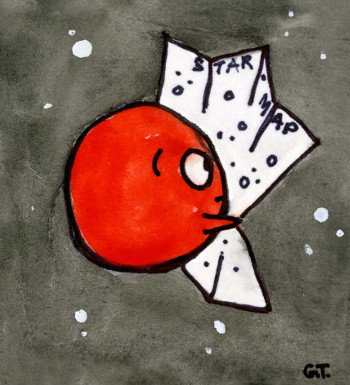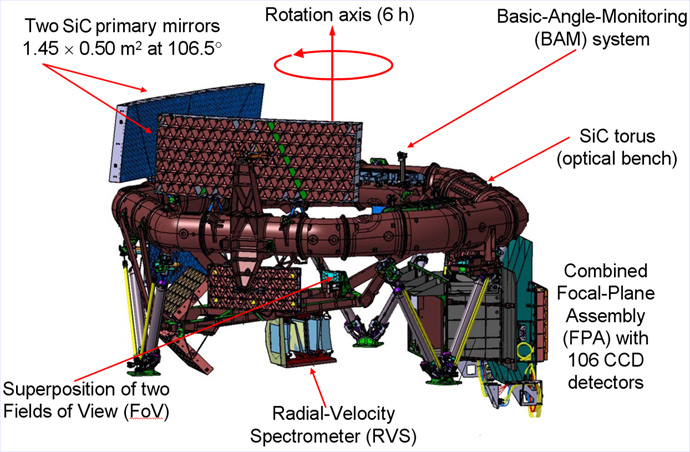Gaia in a nutshell

The main purpose of Gaia is to give us a 3D map of our Galaxy, the Milky Way. Image credit: Grace Treanor.
Status: Science phase underway
Launch date: 19 December 2013
Launch location: European Spaceport, Kourou, French Guiana
Launch vehicle: Soyuz-STB/Fregat-MT
Orbit: 1.5 million km from the Earth in an orbit around a point (called the second Lagrange point, L2) where gravity of the Earth and the Sun balance (see also: Lauch and orbit).
Nominal mission duration: 5 years
Objectives: To create an extremely accurate 3D map of around one billion stars.
In orbit, Gaia scans the sky, spinning around its axis. The fields of view of its two telescopes move across the sky. Gaia completes a full revolution every 6 hours. This allows Gaia to cover the entire sky every six months. Each star will be "seen" by Gaia, on average, 80 times during the 5-year lifetime of the mission.
What does our Milky Way galaxy look like?
We understand the history and the present structure of our Milky Way Galaxy using its fossils – the stars. The chemical elements in a star are the fossil record of its time of formation. The orbit of a star is the fossil record of assembly of the Milky Way itself and the distribution of the mysterious Dark Matter which holds the Milky Way together. Gaia will create an accurate 3 dimensional map of the positions - and motions - of one billion stars in the Milky Way and determine their chemical compositions.
We can do lots of other exciting things with a billion precise measurements:
- Existing measurements tell us there must be some other material which we cannot see – Dark Matter. Gaia will provide the most precise measurements yet of our Galaxy's dark matter distribution, through measuring the positions and motions of stars in exquisite detail.
- A star cluster is a group of stars whose members all formed at the same time from the same cloud of gas and dust. Gaia photometry and astrometry of star clusters will advance our knowledge of the physical structure of stars and how they evolve.
- Gaia's unique place in space (at L2) will also allow it to look back towards the sun and see Near-Earth Objects (or 'Killer asteroids') previously invisible to us.
- Gaia will provide new tests of General Relativity and perhaps detect hints of the next theory of gravity.
- Among the billions of objects Gaia will observe will be 1 million galaxies; 500,000 quasars; 10,000 Supernovae – in real-time; 250,000 asteroids; 15,000 extra-solar planets; 200,000 white dwarfs; 50,000 brown dwarfs, and who knows how many exotic new objects ...
- The night sky is constantly flickering with transient events (objects that change rapidly or in an unusual way), but most of them are too faint to see with the naked eye. Gaia will provide us with a unique way to discover and measure these transient events across the whole sky. These are the Gaia Science alerts.
Gaia's payload

Gaia's payload. The mirrors of the two telescopes and the instruments mounted on optical bench. The telescopes scan the sky as the satellite rotates around its axis, completing a full revolution every 6 hours. View larger image (250 KB). (Image courtesy of EADS Astrium.)
- Two 1.45x0.5 m telescope mirrors, made from silicon carbide.
- The astrometric instrument, used for measuring star positions, from which proper motions (at right angles to us) and parallaxes are derived.
- The photometric instrument, which is used to measure red and blue low resolution spectra (wavelength ranges 320-660 and 650-1000 nm) for each object- these give luminosities and broad stellar compositions.
- The Radial Velocity Spectrometer, which produces a high resolution spectrum (wavelength range 847-874 nm) for radial velocity (motions away/towards us) measurements for the brightest 100 million objects. These measurements will also allow astronomers to determine accurate atmospheric parameters of a smaller number of stars.
- The Camera, the largest ever to be flown in space, just over 104 cm long and 42 cm wide, and containing 1 billion pixels. This camera has been designed and built by Airbus Defence and Space and contains a mosaic of 106 large area, high performance charge-coupled devices (CCD91-72) image sensors, which were custom designed, manufactured and tested by e2V.
